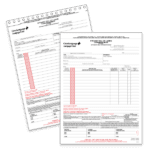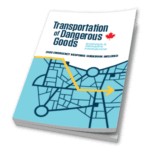Transport Canada Proposes Harmonization Amendment to TDGR
Transport Canada and the U.S. Department of Transportation (DOT) are currently playing a game of “catch-up.” Due to issues such as COVID, our North American regulations have started to fall behind international standards, particularly the UN Recommendations on the Transport of Dangerous Goods, the basis of international dangerous goods regulations.
Fortunately, these agencies have been working hard to create amendments that will keep North American regulations harmonized with the rest of the world. The DOT has already put an amendment in place, HM-215P, to harmonize the “Hazardous Materials Regulations” of 49 CFR with the 21st edition of the UN Recommendations and is already at work on the next in the HM-215 series. In Canada, Transport Canada has just published a proposed update that would harmonize the “Transportation of Dangerous Goods Regulations” (TDGR) with that edition and also improve consistency with 49 CFR. Also, this amendment will be used to give Part 12, the requirements for air transport, a long-awaited update.
The proposed amendment was published in Canada Gazette I on November 26, 2022. Of course, keep in mind that publication in Canada Gazette I means that the amendments are for public discussion by stakeholders, and don’t become finalized until published in Canada Gazette II. So, if you have comments or suggestions, you have until February 9, 2023, to send them to Transport Canada.
So, what are the main changes Transport Canada is proposing? Well, it’s a sizable amendment making extensive changes, and should be reviewed by stakeholders in depth. But here are some of the top changes we’ve noted.
Classification and Shipping Names
Transport Canada noticed that while the UN has revised the criteria for classification since the last major overhaul of the TDGR, not much has been done to track them. It’s been noted that “this lack of alignment means that Canadian consignors are missing out on the use of safer and more practical testing methods for classifying dangerous goods that are not listed under common names in Schedule 1.” The classification system will be updated to reflect current practices. In general, most classes will simply refer to the current UN classification criteria. This will, for example, now allow Canadian shippers to use the UN “calculation” method for Class 8 corrosives.
Note that this involves a wholesale restructuring of Part 2, Classification.
Also, Schedule 1, the list of dangerous goods, needs to be updated. New shipping descriptions have been added, such as UN3549, MEDICAL WASTE, CATEGORY A, AFFECTING HUMANS, solid, and UN3536, LITHIUM BATTERIES INSTALLED IN CARGO TRANSPORT UNIT. UN numbers 3537 to 3548, for articles containing various types of dangerous goods in quantities exceeding limited quantity amounts have been added.
Schedule 1, Special Provisions
A number of special provisions have been created, improved or simplified. These include:
- Combining provisions for classifying vehicles into one provision and providing an exemption for vehicles transported by vessel in Canada, to match the provisions of the International Maritime Dangerous Goods (IMDG) Code.
- Simplifying provisions for classifying ammonium nitrate-based fertilizer.
- Improvements on classifying and shipping kits of various types, such as first aid kits and polyester resin kits.
- Repealing an existing special provision related to dangerous goods classified based on human experience.
- Wet batteries sent for disposal will have the same packaging requirements and relief as non-waste batteries.
Shipping Documents
Transport Canada has proposed some interesting changes to Part 3, Shipping Documents. These include:
- Combining all of sections 3.5 and 3.6 into one complete section on documentary requirements.
- Officially specifying the word “Waste” be put in front of shipping names of wastes, such as on waste manifests.
- Relaxing the requirements that the document must include a heading “24-hour number” or an abbreviation. Instead, the document may include “words with an equivalent meaning.” More clarity is provided regarding requirements for third-party providers of this number, such as CANUTEC.
Safety Marks
The proposed amendment has some changes for safety marks in Part 4, but one of the biggest is in the revocation of sections 9.4 and 10.4, which address reshipping in Canada. There has always been a rather annoying requirement that to reship worded labels on imported goods the shipper must indicate this on the document, stating that the safety marks comply with the regulation under which the goods entered Canada. This will now be eliminated. In general, worded labels and placards may be used as long as the text “does not obscure the symbol.”
Other changes include:
- Introducing size minimums for UN numbers, based on package size, to match UN requirements.
- Authorization of “Inhalation Hazard” labels and placards, to simplify shipping these cross-border.
- Clarification on “misleading shipping marks” and when a mark is considered to be “covered” when inside a closed vehicle.
- Explicit permission to use reduced sized labels on the shoulders of cylinders.
- Clarification on not requiring Class 7 labels on things such as exposure devices.
- Clarification on marking overpacks, such as not having to display two identical class labels if the overpack contains two different products in one class.
- Lithium Battery Marks will now be able to be shown as 100 mm squares, as allowed by the UN Recommendations. However, Transport Canada did not address that the UN is removing the requirement for a telephone number for more information. We hope commenters will point out that doing so in the Canada Gazette II version would eliminate the need for further amendments down the road in this area.
Packaging
Big, or should I say “large” news – there will be a new standard introduced for “large packagings.” These are essentially combination packagings with outer packagings exceeding the 450 Litre limit for “small means of containment.” The UN has referenced these for several years, and it appears they’ll be recognized in Canada now officially in a standard under the Canadian General Standards Board (CGSB) to be identified as CGSB-43.145.
Also, it appears that the Transport Canada standard TP14850, for small means of containment of most classes, will be removed and recreated as a CGSB standard, CGSB-43.150, to match the large means of containment and intermediate bulk containers (IBCs), which are already under the CGSB.
Flexible IBCs would be able to be used to transport soils contaminated with flammable liquids under some conditions.
ERAPs and Reporting
These parts have some minor modifications and clarifications. Most notable is one that requires reporting under Part 8 for the implementation of an Emergency Response Assistance Plan (ERAP).
Part 9, Road and Part 10, Rail
Some significant changes have been made here to enhance harmonization with 49 CFR, including the already-mentioned permission to reship packages with worded labels without having to note them on the document. For example, the ban on recognizing US-style inhalation hazard labels and placards is removed.
Part 12, Air
The whole of this section has been restructured. The ICAO Technical Instructions for the Safe Transport of Dangerous Goods by Air have been incorporated by reference and are “the primary source of requirements for the transport of dangerous goods by air.” An attempt has been made to clarify when ICAO applies and when the TDGR takes priority, for example specifying that dangerous goods training for air in Canada must meet TDGR requirements, not ICAO’s. They also require the use of TDGR’s requirements for classifying explosives in Class 1.
The reporting requirements for air transport have been shifted from Part 8 to Part 12 and are now required to be submitted by carriers electronically rather than by telephone.
The new Part 12 will recognize many ICAO Technical Instructions exemptions, such as for medical supplies, as well as some from the TDGR, such as those for shipments under the Department of National Defense.
To harmonize with ICAO, shipping documents will only need to be retained by consignors and carriers for a minimum of one year.
A number of changes have been made to the requirements for remote access locations to simplify the delivery of supplies such as hand sanitizers and alcohols, bear repellents, paint, wet batteries and vehicles or machinery.
Conclusions?
This is an impressive amount of work and should simplify the lives of importers and exporters of dangerous goods in Canada. However, stakeholders should read the proposal carefully. As one regulator told me “We can’t fix problems we don’t know about.” So, if anything strikes you as ill-advised, or if you see something that could be made even better, let Transport Canada know before February 9. And if you see something that you really want to go through, be sure to let them know that this is something they need to keep.
Questions?
Do you have questions about this proposed amendment? Are you interested in keeping track of Transport Canada’s plans, or what the DOT is working on? Contact our Regulatory Experts. We can advise you on current and upcoming regulations.
Sources:
Canada Gazette Part I, Volume 156, Number 48, “Regulations amending Certain Regulations Made Under the Transportation of Dangerous Goods Act, 1992 (Part 12 and International Harmonization Update)”
Justice Canada, Transportation of Dangerous Goods Regulations
UN Recommendations on the Transportation of Dangerous Goods, Rev. 22 (2021)
Stay up to date and sign up for our newsletter!
We have all the products, services and training you need to ensure your staff is properly trained and informed.
 Canadian Dangerous Goods bills of lading Canadian Dangerous Goods bills of lading |
 Canadian TDG Publications |
 Shipping Dangerous Goods by Ground (TDGR) |






